Treasures of Egypt's Atlantis: Raised from the deep after 1,300 years - and now on dazzling show in the British Museum
City of Thonis-Heracleion - deep in the Mediterranean - was exposed to the world by a French archaeologist in 2000[CN]
Thonis-Heracleion 之城 - 在地中海腹地 - 2000年由法国考古学家公之于世。
Christened the 'Egyptian Atlantis', it was the most important Mediterranean trading port in Egypt for over 500 years[CN]
这座城市被冠以“埃及亚特兰蒂斯”之名,是埃及500年来最重要的地中海交易港口。
Some of the great treasures carved by the ancient Egyptians, and the Greeks and Romans, have been found there [CN]
古埃及、古希腊、古罗马创造的一些巨大财富,在这里都有发现。
Now the undersea metropolis of toppled temples and statues of gods is on display at the British Museum in London[CN]
如今这座满是坍塌庙宇和神像雕塑的海底大城市在伦敦大英博物馆展出。
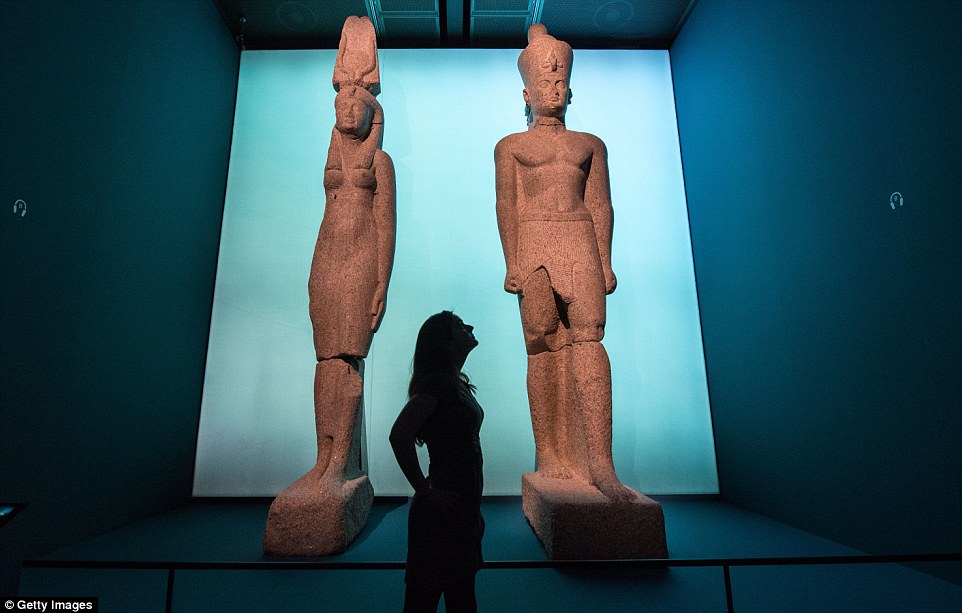
Towering: The 16ft statues of an Egyptian king and queen, pulled from the city of Thonis-Heracleion in the depths of the Mediterranean[CN]
高耸屹立:16英尺长的埃及国王和皇后,从地中海腹地的Thonis-Heracleion之城取出。
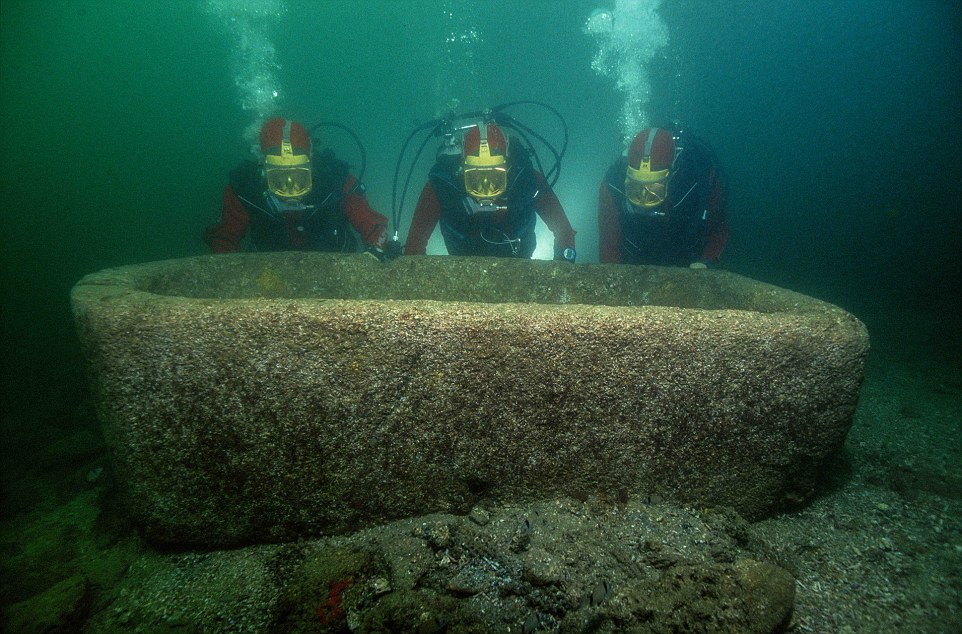
Rescue operation: Three divers examine the underground world of treasures that was discovered at the ancient site near Alexandria[CN]
拯救行动:三个潜水员在亚历山大港附近清点海底世界古遗址的财宝。
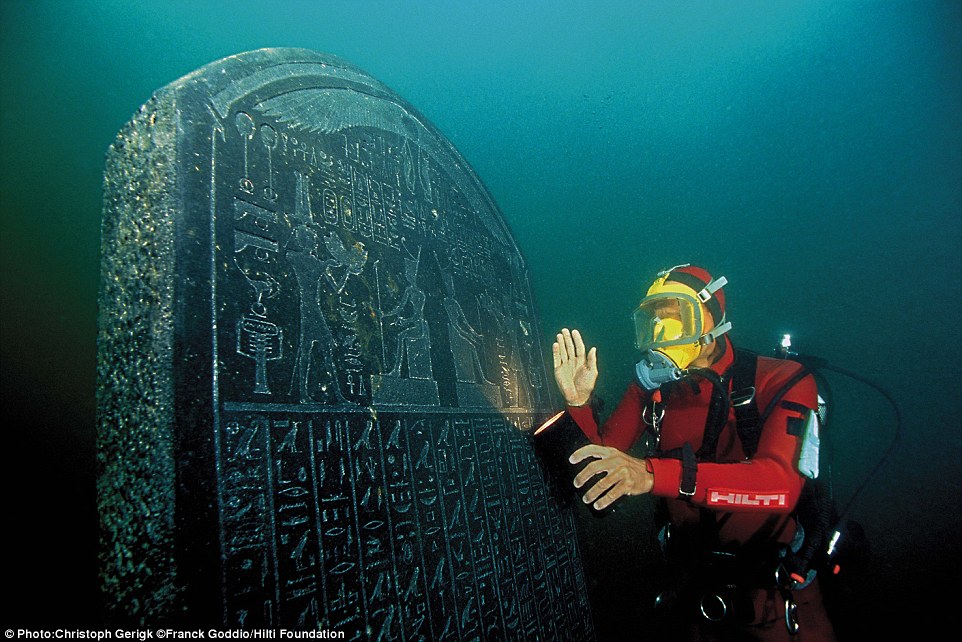
Discovery: The city itself wasn’t exposed to the world until 2000, when a French archaeologist swam deep down into the Mediterranean, two miles off the Egyptian coast near the city of Alexandria[CN]
发现:这座城市直至2000年才公之于世,一名法国考古学家游到地中海深处,离亚历山大城市的埃及海岸有两英尺远。
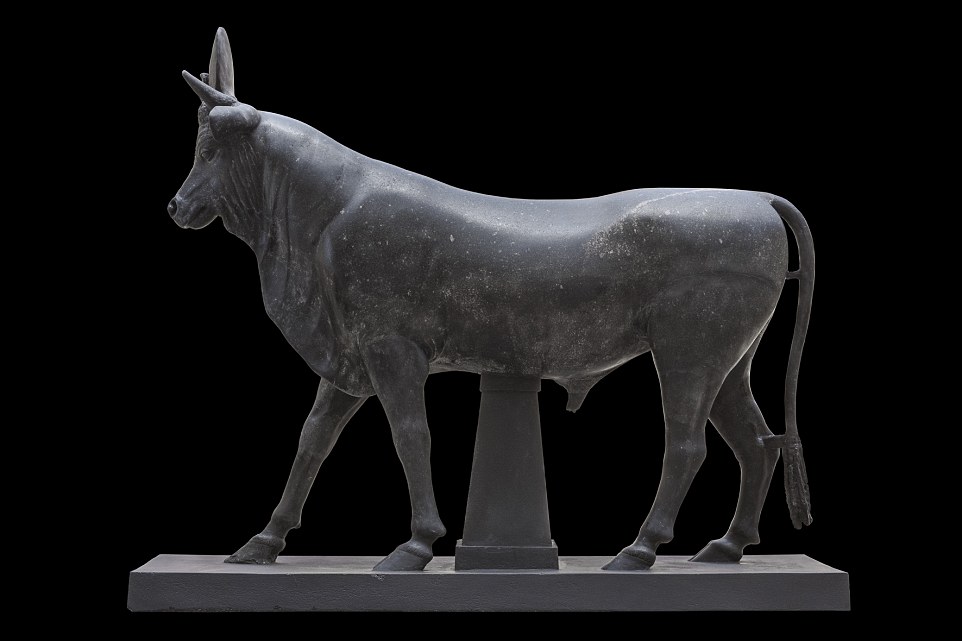
Crossover: This 6ft statue of the Egyptian bull god Apis dates from the time of the Roman Emperor Hadrian - Romans often adopted local deities when colonising a new region[CN]
跨界:这尊6英尺的埃及公牛圣牛可追溯到罗马哈德良皇帝时期 - 罗马人新占领了一个地方后往往采用当地的神灵作为圣物。


Worship: Archaeologists have worked out that the earth beneath the major temples actually turned to liquid, thanks to a geological process called liquefaction, and most of the city’s glittering buildings and statues went spiralling down to the bottom of the sea
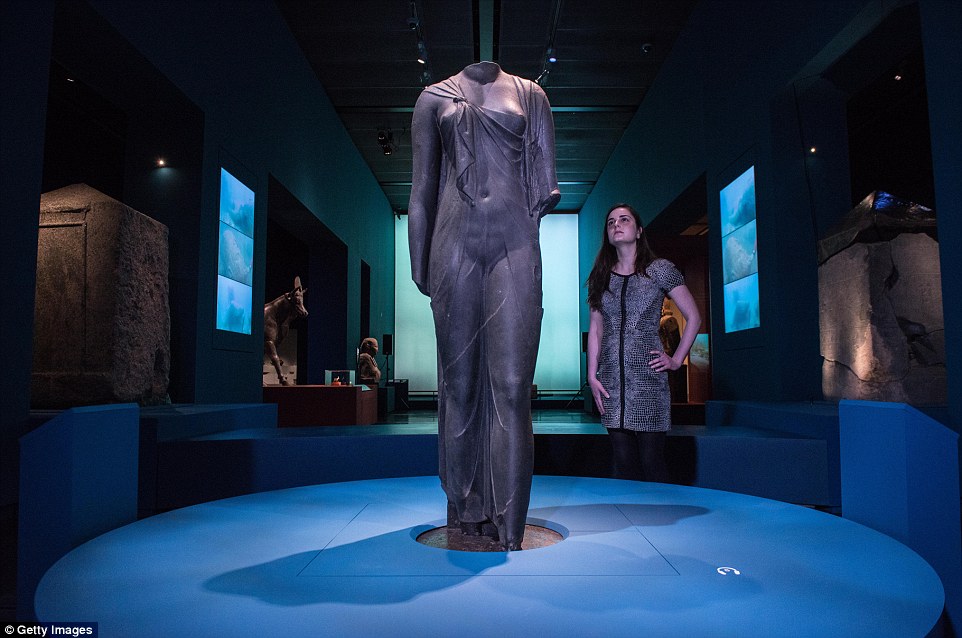
Miraculous: Archaeologists found a stupendous collection of statues of pharoahs and deities, glittering golden plates and coins, 69 shipwrecks and more than 700 anchors
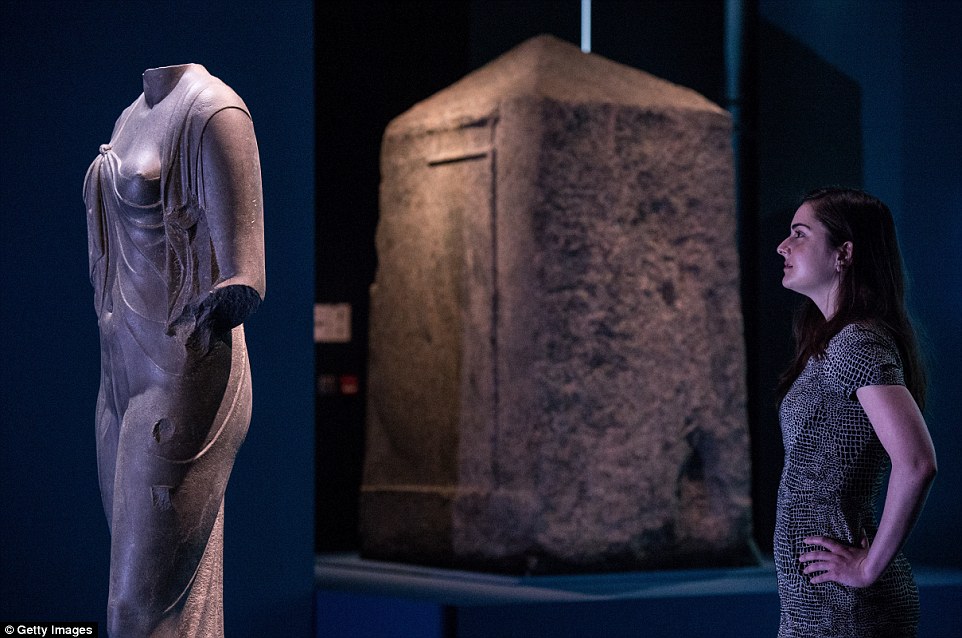
Find: Some of the great treasures carved by the ancient Egyptians, and the Greeks and Romans who followed them, have been unearthed at Thonis-Heracleion
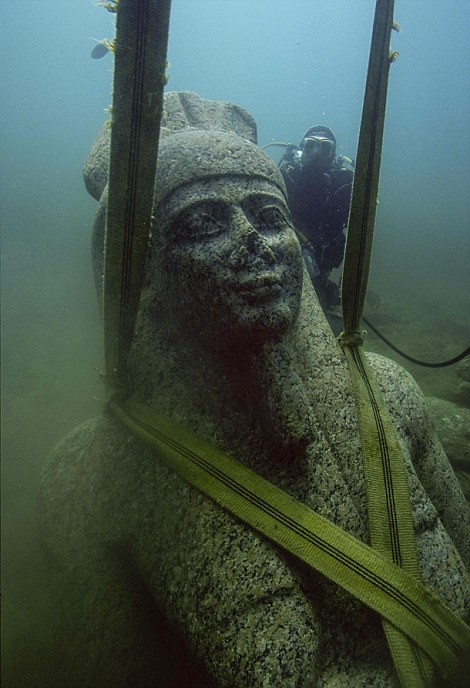
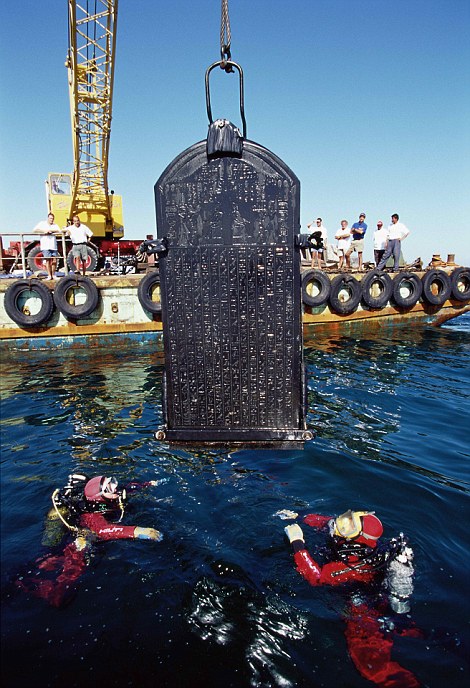
Rising from the depths: A 17ft-high statue of the Nile god Hapy (left) was discovered in seven pieces and had to be carefully winched up from the seabed, reassembled and cleaned. Pictured, right, is an Egyptian tablet that raised new taxes
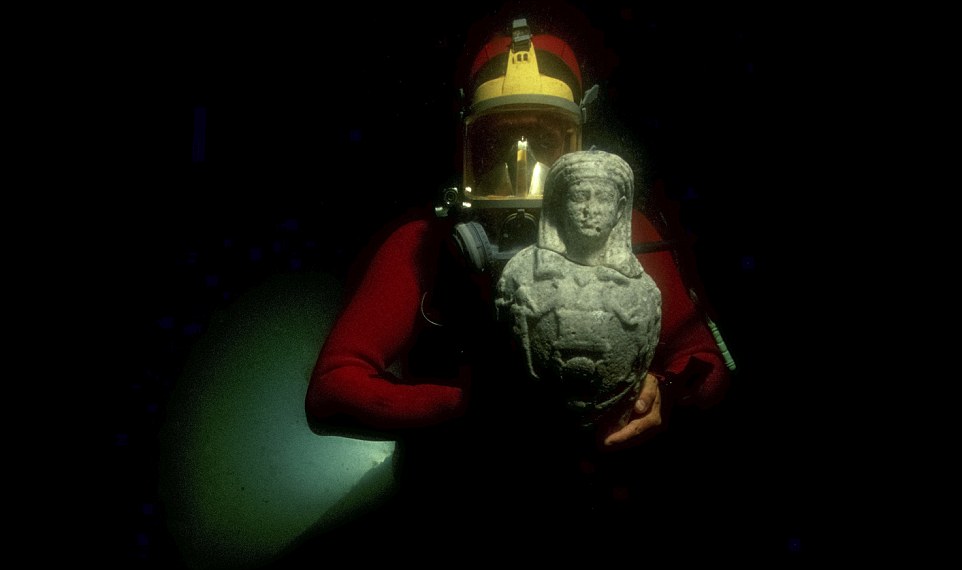
Saved from the sea: The range of finds at the ancient site is staggeringly wide and exotic, and includes artefacts from the Egyptians, the Greeks and the Romans
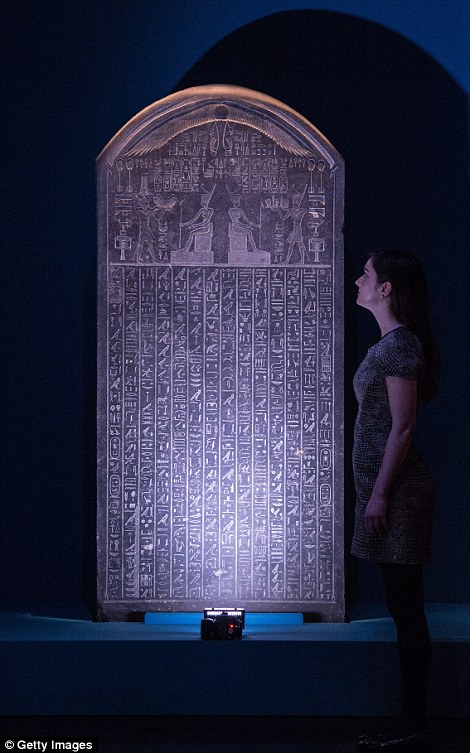
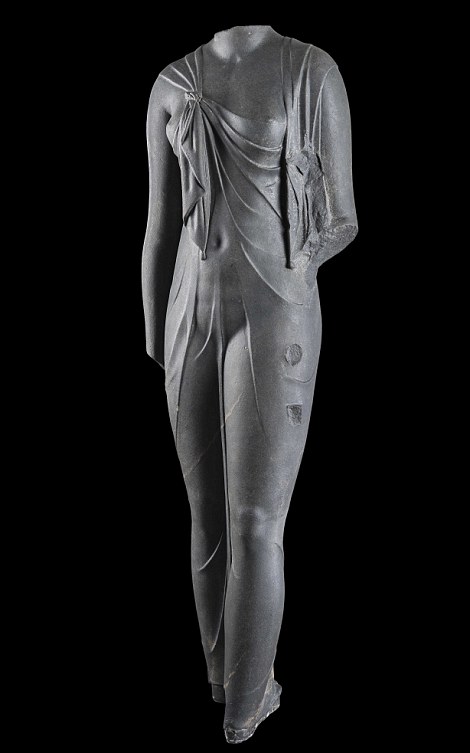
History: After the Greeks, the Romans came, conquering Egypt in 30 BC, when the future Emperor Augustus defeated Mark Antony and deposed his lover, Cleopatra
For 1,300 years, the legend of a lost Egyptian city was exactly that — a legend. The earliest Greek historian, Herodotus, said the metropolis of Thonis-Heracleion derived its name from being the place where Heracles, the mythical strongman, first set foot on Egyptian soil.
And Helen of Troy — the most beautiful woman in ancient mythology — supposedly visited the place with her lover, Paris, 3,000 years ago.
But the city itself wasn’t exposed to the world until 2000, when a French archaeologist swam deep down into the Mediterranean, two miles off the Egyptian coast near the city of Alexandria.
There he found the ‘Egyptian Atlantis’, a city that for 500 years from the 7th century BC was the most important Mediterranean trading port in Egypt.
What the Frenchman found was a huge undersea world of toppled temple columns, statues of Egyptian gods and hieroglyphics etched into ancient slabs, seen only by shoals of fish for centuries.
At the end of the 2nd century BC, this thriving city was hit by a triple whammy of earthquakes, floods and geological subsidence.
Archaeologists have worked out that the earth beneath the major temples actually turned to liquid, thanks to a geological process called liquefaction, and most of the city’s glittering buildings and statues went spiralling down to the bottom of the sea.
A few hardy Christian souls clung on in the remnants of the city until it all slipped beneath the waves in about AD800.
Today, the murky waters of Abukir Bay, at the mouth of the Nile, are thick with sediment, and at first it was hard to work out what the huge chunks of stone half-buried in the seabed in 30ft of water might be.
On closer examination, they found a stupendous collection of statues of pharoahs and deities, glittering golden plates and coins, 69 shipwrecks and more than 700 anchors — all miraculously preserved in their undersea grave, safe from looters and vandals.
Ever since, some of the great treasures carved by the ancient Egyptians, and the Greeks and Romans who followed them, have been unearthed at Thonis-Heracleion. And now they are on display in a new exhibition at the British Museum in London.
Greeting you, as you enter, is a 17ft red granite statue of Hapy — Egyptian God of the Nile, whose waters swallowed up the rest of the benighted city 1,300 years ago. In his arms, the 4th century BC statue has an offering table, to hold gifts for the god whose name he bears.
Since the city was an international harbour, a huge variety of antiquities were found. They were so two-a-penny there was even a statue ‘tip’: among its many treasures is a smiling bust of the Egyptian king, Nectanebo II, who ruled Egypt in the mid-4th century BC. One sphinx plucked from the seabed presented a particularly curious riddle. Its human head was found in a temple, while its lionshaped body was discovered 650ft away.
Archaeologists think the sphinx was amputated by a passing trawler — looking for fish, not multi-million-pound antiquities.
The best of all the statues are a beautifully carved and beautifully preserved king and his queen, standing side by side, both 16ft tall. They towered over visitors at a preview of the show.
Thought to have been carved in the 3rd century BC, they guarded the entrance to the temple of Amun-Gereb — the god who granted the pharaohs their legal ‘right’ to rule Egypt.
The range of finds is staggeringly wide and exotic. A pile of 6th-century BC sarcophagi, or stone coffins, were found under 5ft of sediment. Intriguingly, they were for animals — the falcon and the ibis, the two birds venerated by the Egyptians. Just like human mummies, the birds were wrapped up in a tight cloth binding.
Some things are a bit more familiar to us.
As the saying goes, the only two things you can be certain of in this world are death and taxes — and the Egyptians were no different. One huge monument, in immaculate condition, is inscribed with what you might call tax-raising hieroglyphics.
These declare that the pharaoh Nectanebo has issued a royal decree, charging taxes on imports and exports passing through the port of Thonis-Heracleion.
The tax — 10 per cent — paid for a temple in honour of Neith, Nectanebo’s mother.
Our politicians are a rum lot, but they haven’t started taxing us for temples honouring their mothers. Yet.
In 332 BC, Alexander the Great conquered Egypt, turning this thriving port into a Greek city, and leaving it stuffed with Greek treasures.
After the Greeks, the Romans came, conquering Egypt in 30 BC, when the future Emperor Augustus defeated Mark Antony and deposed his lover, Cleopatra.
A statue of a priest from the Roman era was discovered still standing in the sand, clutching a jar which was sacred to Osiris, the Egyptian god of the dead.
The Romans often adopted local gods like Osiris when they set up new colonies.
All in all, you get a super-sharp picture of life in Thonis-Heracleion, across the three great civilisations of Egypt, Greece and Rome.
That is, until this bustling, metropolitan Mediterranean hub plunged into its watery grave.
For centuries this sunken treasure house slumbered beneath the hazy waters of the Mediterranean until, one extraordinary day in 2000, an archaeologist happened to come swimming by.
As reported in the DM 16th April, this city was actually found by an RAF pilot in 1933. Flying over the bay he had noticed dark shadows in the water. He told a member of the Egyptian royal family who sent a diver down, who came back with a head of Alexander the Great. It was not, therefore, discovered by a French archaeologist who happened to be swimming past, he knew what he was looking for.[CN]
DM4月16号报道,这座城市实际上是1933年英国皇家空军飞行员发现的。他飞过这边湾区,发现水底有一些很深的影子。他告知埃及王室成员派遣潜水员下去,带回了亚历山大的人头。所以说,不是法国考古学家碰巧游过而发现的,他知道他要找的是什么。
Greece will probably include these items to be returned along with the Elgin Marble's[CN]
希腊可能又想连带这些东西和尔金大理石雕塑一起召回。
@James. All ancient treasurs are well preserved and safe in some of the world's most important museums in Greece. What makes you think that your country has done a better job preserving the Marbles that Elgin brutally took from Athens partly destroying them by leaving them to unskilled labourers who had used copper chisels and wire brushes to clean the marbles deforming them while the remaining marbles in Athens are in a much better condition and excibiting in London which by the way is an amazing city but doesn't have the potential to accomodate pieces af art that are supposed to be laid under the strong Athenian light. With a lot of respect search your facts.[CN]
@James。 在希腊世上最有重量级的一些博物馆中,所有的财宝都保存的很好,很安全。你认为你们国家在保存工作上做的更好,实际是强行从希腊拿走的,交给不熟练的工人又毁掉了一部分,他们用铜制凿子和钢丝刷来清洗塑像使其变了形。而雅典留下的大理石塑像就好多了,比伦敦的要更激动人心得多。顺便说下,伦敦城市不错,但是要保存原是雅典之物的小块艺术品可就尚缺火候了。谨奉上事实以供参考。
I love it - "all miraculously preserved in their undersea grave, safe from looters and vandals" - that is until the French Archaeologists arrived and looted the sites :) Pretty spectacular items though![CN]
我喜欢 - 这些宝物在海底坟墓都保管的好好的,没有偷盗,没有破坏 - 直到法国考古学家到来,掠劫了这个遗址。这些文物还是挺宏伟的。
Such incredible skill - to take a piece of stone, and by carving it, create something that looks like a women (sadly now headless) draped in thin fabric. A true artist.[CN]
难以置信的技术 - 抽一块石头,精雕细琢,就创造出了像女人一样的雕塑(可惜头部没了),身着细纱。真艺术家啊。
Even more incredible when one realizes they didn't have Iron tools, only thin soft copper tools that wore out quickly. Iron was a very scarce luxury item. Tutankhamen was buried with an iron knife blade.[CN]
更惊奇的是,他们没有铁工具,只有一些薄薄的铜工具,很快就弄坏了。铁还是很稀有的奢侈品。Tutankhamen被埋时就用铁剑下葬。
Let me guess Europeans did all the work to find and retrieve them once found Egypt will cry and cry till they are given to them .[CN]
要我猜就是欧洲人拼了命去寻找,找到了就要立马归还。埃及人就一直哭丧着哭丧着,直到我们给回他们。
Magnificent! I wonder if artists are making art now that people will be awestruck with 2000 years from now?[CN]
太神奇了!我想知道有艺术家在做过了2000年后,后人也会觉得很震撼的艺术品吗?
Until you actually visit Egypt and see this magnificent artwork in situ¿you can not appreciate its true beauty. Words can not describe them or the emotions experienced by those experiencing being in their presence. They can bring a tear to a glass eye.--I would urge EVERYBODY to make at last one visit. --You need not be a scholar, just an interested party.[CN]
知道你去过埃及,看到那里神奇的艺术品,才能真正体会它最真实的美丽。语言无法表达这些景象,也无法写出亲临现场的那种震撼。玻璃眼看了都会流泪。我想呼吁大家都去游一次。,你无须当一个学者,只做一个有兴趣的人就行了。
They should be in Egypt, the same as the Elgin marbles should be in Greece. Oh I forgot, then there should be nothing left in the London museum...[CN]
应该还回埃及的,同理尔金大理石雕塑也该在希腊。哦,我忘了,这样一来伦敦博物馆就啥都没有了。





















